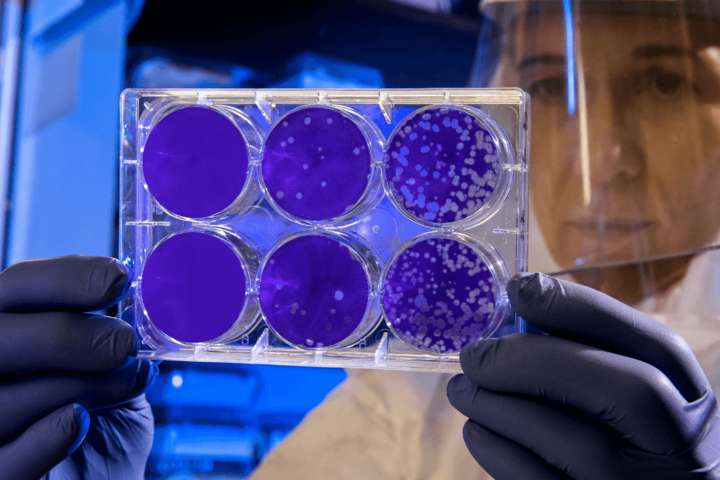In this blog post, we explain why reusable plastic water bottles can become harmful bacteria traps and why you can get sick reusing a water bottle. We also explain why using a naturally anti-microbial, self-sterilizing copper water bottle can be a great alternative. Let's get started!
Introduction
Reusable water bottles are handy tools to quench our thirst on the go and avoid dehydration. They are easy to carry around and reach to when we need a drink. If you lead an active lifestyle, you probably can’t get by without a trusty reusable water bottle.

If you care about the environment, you also know that using a reusable water bottles is the only way to go. Disposable plastic water bottles comprise the highest percentage of waste found in landfills. In fact, in a recent study it was determined that 50 billion plastic water bottles are discarded each year.
In addition, on average only 1 in 5 plastic bottles are recycled, and plastic bottles take between 400 and 1000 years to decompose. Did you also know that it requires three times as much water to produce a plastic bottle as it does to fill it?
In the US alone, 1,500 plastic bottles are opened every second on average. One recent study also found that an estimated 5 trillion pieces of plastic waste are floating in the ocean, much of which comes from plastic water bottles.
Reusable water bottles are also much more cost-effective than disposable water bottles. According to Earth Day, the average American buys more than 160 plastic water bottles and spends more than $200 each year. One could save thousands of dollars opting for a reusable water bottle instead.
Although reusable water bottles have many virtues, they do not come without risks. In particular, reusable water bottles can pose health risks caused by the growth of harmful bacteria. Since the nature and function of reusable water bottles involves moisture, they can become breeding grounds for bacteria.
In this blog post, we explain how bacteria can proliferate in reusable water bottles and how you can take precautionary steps so that you can continue using your bottle safely. In addition, we will also explain why the special characteristics of copper make copper water bottles naturally self-sterilizing.
What You Need to Know About Bacteria
Before understanding how to avoid the growth of bacteria in our reusable water bottles, we need to understand what bacteria is and how it thrives.
Bacteria are tiny, single-celled microorganisms that are capable of thriving in different environments. They typically appear in three shapes - round (cocci), cylindrical (bacilli), and spiral (spirilla). One of the means by which bacteria proliferates is through binary fission, which is where a single cell duplicates its DNA and the replicating copies are pushed out of the ends of its cell. Bacteria requires certain environmental conditions for it to reproduce. There must be a warm temperature, moisture, a conducive pH level, and oxygen.

While some bacteria is highly beneficial to the human body, other bacteria can cause serious illnesses. An example of helpful bacteria is lactobacilli, which helps in digestion. On the other hand, an example of a damaging bacteria is salmonella, which can cause food poisoning.
In one recent study, research was conducted to investigate the types of bacteria that grow in reusable water bottles. The researchers took swab tests from reusable water bottles that athletes drank from and found that the reusable water bottles hosted both harmless and harmful bacteria. The harmless bacteria that thrived in the containers included bacillus and gram-positive rods. Dangerous bacteria that grew on the bottles included gram-negative rods and gram-positive cocci, which can cause strep and staph infections and can be resistant to antibiotics.
Risks of Using Bacteria-Contaminated Water Bottles
As various studies have shown, reusable water bottles can become environments that are prone to cultivating harmful bacteria. In fact, reusable water bottles that have not been washed for a week have been found to host gram-negative rods and gram-positive cocci. When the water you are drinking is highly contaminated by these bacteria, it can cause diarrhea, urinary tract infection, and sepsis, among other infections and illnesses.
Various research has also been conducted to investigate the link between bottled water and pseudomonas aeruginosa, a gram-negative rod-shaped bacterium that is capable of causing diseases in plants, animals, and human. One such study collected bottled water samples after up to 30 days in storage. The results showed a very significant increase in the size of the bacteria colonies. The research also demonstrated that the bacteria were able to increase at a much higher density than they would in other environments.
Another similar study showed the predominance of pseudomonas in reusable water bottles and suggested that outbreaks of diseases caused by bottled waters have more to do with contamination than the quality of the water source. Another study, which had a duration of eight months and tested eight different kinds of bottled drinking water, recovered nine types of pseudomonas from the bottles, among them p. stutzeri and p. diminuta, both of which are harmful bacteria.
Preventing Bacterial Contamination
The best way to minimize your exposure to contaminated water caused by bacteria is to make sure that you are using a water bottle made from the right material. Some materials, such as copper, are far more resistant to bacteria growth than other materials such as plastic, glass, steel, or other metals.
Plastic
Plastic is the most common type of material from which reusable bottles are made. This is likely because plastic is also the cheapest material from which to make water bottles.
Be sure to be careful that any reusable plastic bottle you use is BPA-free. The presence of BPA (bisphenol A) is linked to fatal illnesses like cancer, particularly when the body is exposed to it frequently. BPA has been identified as an environmental toxin which may disrupt the development in humans by advancing the rate of puberty.
Accordingly, if you must use a plastic water bottle, make sure you only use bottles that are made of high-density polyethylene (HDPE #2), low-density polyethylene (LDPE #4), and polypropylene (PP #5), as these materials are the least likely to leach harmful chemicals. However, these materials tend to be less durable, and can retain odors and stains, and also leak. In addition, plastic bottles tend to be problematic havens for the growth of bacteria, which make them less desirable.
In addition, the environmental harm caused by plastic water bottles should encourage you to consider other options.
Copper
Water bottles are increasingly made from copper, which has been used since ancient times to disinfect and purify water. Interestingly, studies have repeatedly shown that copper bottles actively kill bacteria that comes into their presence through a process known the oligodynamic effect.

In one recent study, researchers inoculated water samples with e. coli, salmonella typhi and vibrio cholerae and stored it overnight in a copper vessel at room temperature. The bacteria was no longer recoverable when the researchers examined it the next day, which was an incredible result compared to water stored in control glass bottles under the same environment (in which the bacteria continued to grow and flourish).
Copper water bottles also have a variety of additional health benefits, including creating natural alkaline water.
Glass
Glass is another common material from which reusable bottles are made. Water bottles are often praised for being able to retain the natural taste of water. However, glass bottles are not a practical choice if you aim to keep your baggage light, and they can also shatter easily when dropped. In addition, glass bottles are poor choices when it comes to avoiding the growth of bacteria.
One recent study investigated bacterial growth in water stored in glass containers. The researchers determined that bacteria could easily multiply on the glass container’s surface and in the body of the water itself. In the result, the researchers concluded that the number of bacteria grew excessively compared to water in natural conditions.
Stainless Steel and Aluminum
Stainless steel is another common type of material from which to make water bottles. Such water bottles are typically made of culinary-grade stainless steel.
While stainless steel bottles are generally more lightweight durable than glass, a study by Stanley determined that stainless steel is vulnerable to the irreversible attachment of pseudomonas aeruginosa. The researchers found that when the bacterial cells came into contact with stainless steel, they irreversibly attached in less than one minute and then began to multiply. Stainless steel bottles are also not very good at resisting the formation of unpleasant odors.
Aluminum water bottles are crafted through fashioning an aluminum puck into a cylindrical shape using a metal press. Aluminum bottles are generally shock-proof and can resist odor formation. However, aluminum insulates liquids poorly, and condensation can form outside the bottle when cold water is stored within it.
Like stainless steel, aluminum can also be unsafe when exposed to hot temperatures. Aluminum is also reactive with acidic substances and must be lined with an enamel or epoxy layer. Unfortunately, researchers have determined that the epoxy layer used in many aluminum bottles contains BPA, which is one of the primary components used when creating aluminum bottles.
One study was conducted to probe the trace amounts of metals in water stored in metal water bottles. The experiment involved testing 132 different brands of bottled water from different countries. Leaching experiments were also conducted. The researchers found that some of the water had an exceedingly high amount of aluminum, beryllium, manganese, and uranium. The researchers also cautioned against certain metal bottles which contaminated harmful levels of toxic trace metals like antimony and thallium.
Cleaning Your Water Bottle
Regardless of the material from which your water bottle is made, you should never allow it to sit around for days without washing it, with the exception of copper water bottles which are naturally self-sterilizing.
Ideally, you should scrub your water bottle daily with soap and water. Bottles with a wider mouth will be easier to reach inside for cleaning. If your bottle has a narrow mouth, use a brush to scrub the inside of your bottle.
About the Authors: This article was collaboratively written by our team of researchers and writers with the benefit of all available scientific studies and other relevant literature. Our team of researchers and writers include experienced health researchers including a qualified medical professional. Please note that information in this article is not intended or implied to be a substitute for professional medical advice, diagnosis or treatment.
Did You Enjoy This Article?
Thank you for reading! If you enjoyed this article, you might also like the following articles: Staying Healthy While Traveling: Complete Guide and Ayurvedic Diet: Complete Guide


2 comments
Mar 08, 2020 • Posted by Copper H2O
Hi George, thanks for your question! This post was originally published on June 17, 2018 and has been updated several times since then, including today, March 8, 2020. Hope that helps and good luck with your assignment!
Mar 08, 2020 • Posted by George Parfitt
Hi, i was wondering what date the article on avoiding bacteria in water bottles was released as i am trying to reference information from it for assignment. Any information would be much appreciated,
Thanks
George
Leave a comment: